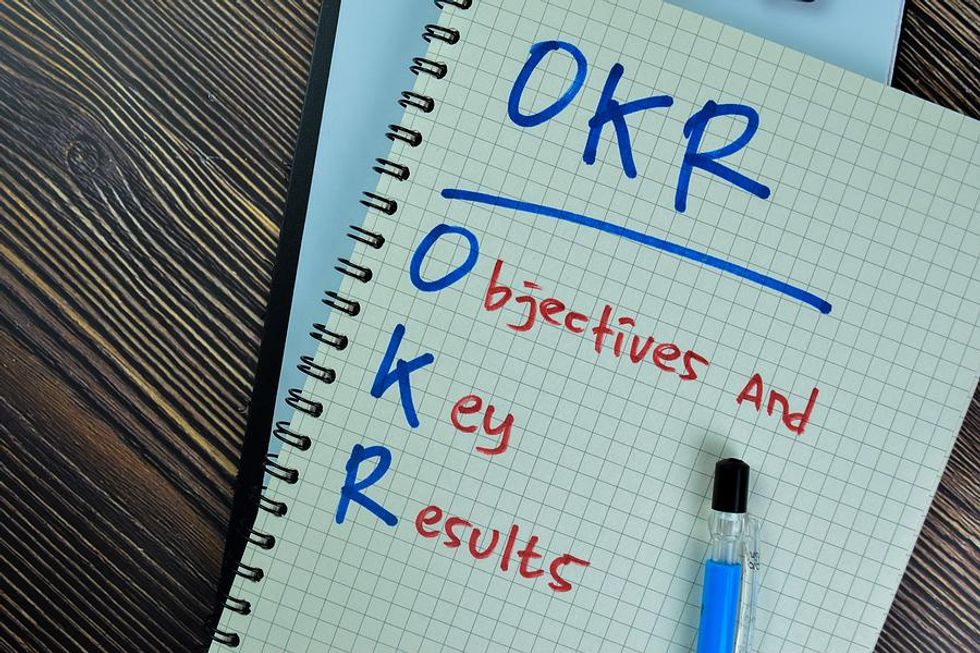
It's that time of year again! Companies are setting goals and finalizing their business plans for the next 12 months. Business leaders might have high-level goals for their organization, but each team within the organization must have its own goals it wants to achieve to make the high-level goals a reality, and a detailed plan on how to accomplish them.
We recently asked our leading executives to share their best tips for team goal setting and business planning.
Here are their responses...
John Schembari, Senior Education Executive
Have the team review performance data. What does the data say? Why is this important? What should we do next? To help in this analysis, the team can review its organization's mission, vision, and/or brand statement. Once the team has determined two to three main goals on which to focus within its strategic plan, consider department—or organizational—strengths, opportunities, weaknesses, and threats. What strengths does the team currently have to meet these goals? How might the team seize new opportunities to achieve success? How will the team compensate for its weaknesses and mitigate the potential impact of threats?
After, consider the milestones/benchmarks—data, artifacts/evidence, etc.—that will determine progress toward each goal, articulate what ultimate success for each goal will be, define who is responsible for each goal, and the time stamp when each goal will be met. Goals should be specific, measurable, achievable, relevant, and timely (SMART).
John Schembari is a current K-12 teacher/school leader academic improvement coach and former school building and district administrator. He loves to draw, travel, swing dance, and read nonfiction.
Kathleen Duffy, Founder, CEO, And President Of Duffy Group

Image from Bigstock
We began planning for 2023 in August. Our session was facilitated by an outside consultant who sent our 2022 plan to all participants and asked us to look at the SWOT. We met in person to update the SWOT; critical strategic issues were identified from the "W" section, and our strategic initiatives to support the critical issues were developed. A work plan was created for each strategic initiative with target dates for completion; we meet monthly to review the dashboard coloring our progress—red, yellow, or green. We also reviewed and updated our three-year metrics of success, such as company revenue, client retention, quality, and efficiency, to share a few metrics we collect.
Kathleen Duffy is the founder, CEO, and president of Duffy Group. The company's vision is to elevate recruitment research as an alternative to contingent and retained search. Since its founding, Duffy Group has been a remote workplace and a culture of work/life harmony.
Ana Smith, Talent Architect & Global Learning Strategist

Image from Bigstock
A quite popular and effective goal-setting framework for teams is OKRs (objectives and key results). They are an effective method for not only planning but also for measuring success on a team level. One shortfall at a company level is when they try to apply OKRs at an individual level.
The complexity that comes from setting individual OKRs generally leads to goals that are either not indications of meaningful progress or easily gamed. Instead, individual contributors should be assessed based on the extent to which their work contributes to team goals that add real value to the company and its customers.
Objectives and key results, or OKRs, have become one of the most popular frameworks for teams looking to plan and measure the success of their work.
With this system, leaders at each and every level of the organization start by:
- defining high-level, qualitative, inspirational goals, called “objectives”
- defining who will be the consumer of their team’s work, and
- determining what behavioral changes, they would expect to see in those consumers that could be used to quantify whether the team is achieving its high-level goals.
Ana Smith helps people & organizations achieve their full talent potential by developing and co-creating people strategies and customized solutions, and turning them into impactful outcomes and collaborative relationships, using coaching as the "red thread."
Michael Willis, Sports Business Operations Executive

Image from Bigstock
I believe every employee should know three things about the company they work for:
- Mission
- Goals
- Competitors
While we work in teams, our goals and business planning should align with the company’s objectives. Everyone must be working toward the same outcome.
Team setting goals and objectives should be measurable. This is my favorite part. As a part of the accounting/finance world, I am heavily invested in the company’s annual budget. The budget can drive an opportunity to develop metrics.
Budget Comparisons:
Ø Prior year actuals to current year’s budget
Ø Current year’s budget to current year’s forecast
I like to calendarize the budget. This means that I spread the budget out over 12 months. So I don’t have to wait until the end of the year to realize a problem or opportunity. This kind of analysis will drive something to talk about every month.
By capturing trends in your analysis, you can visualize past performance versus how you are pacing in real time.
Michael Willis has 18+ years of experience working with accounting & sports organizations and has managed P&Ls of $10M - $125M+ with budgets of $3M-$50M+. He worked for the NFL for 22 1/2 years, mainly with the game officials working on the financial/accounting side of the business.
Mark Taylor, Product & Operations Executive

Image from Bigstock
It seems reasonable to assume that the tsunamis of work pushed our way in 2022 will not abate in 2023.
Setting goals and planning will be ineffective—the equivalent of holding one’s hand up against incoming tidal waves.
If planning is an attempt to manage overwhelm, a more effective practice is self-prioritization. Consider it the ongoing art of identifying and understanding those tasks that need to be done right now—and ensuring you stay half a step ahead.
Similarly, if goal setting is the company making sure they get value from you, delivering your tasks on a timely, accurate and complete basis—and presenting the results in an easily digestible form—will address this need.
Come the end of 2023, if you’ve identified and delivered strongly on those tasks that the business deemed important, you’ll be considered effective…
…and live to do it all again in 2024.
Mark Taylor has 20+ years of risk, technology, and product management experience working in global and regional financial services firms in the UK and the U.S. He's managed teams of 40+, successfully addressed 100+ regulatory issues, and has saved companies $15M+.
Sarita Kincaid, Tech Media & Influencer Relations Executive

Image from Bigstock
The most important rule of thumb when creating goals is to always align with the top business goals in your organization. These CEO-level goals are usually around revenue and market share growth but may also be, to a lesser extent, about brand, customer experience, or thought leadership.
Analyst and media relations professionals should always, especially in challenging economic times, ensure that their planning process starts with business goals to ensure that the value they bring contributes directly to C-level priorities. If top-level business goals aren’t being cascaded through the organization, interview relevant C-level executives to find out what they are being tasked to achieve.
Other than starting with organizational business goals as the guiding light of the planning process, I advise analyst relations professionals, in particular, against setting “counting” goals. These are metrics around the amount of outreach. Conducting 100 briefings a year isn’t significant if it doesn’t result in an increase in analyst perception, likelihood to recommend your company/product, or improved positioning in landscape vendor reports.
More on best practices for building an effective analyst relations plan.
Sarita Kincaid is a tech media executive with a demonstrated ability to build and grow award-winning programs. She brings a data-driven approach to influencer relations with a focus on developing strong brand advocates and aligning them with sales programs.
Lisa Perry, Global Marketing Executive

Image from Bigstock
With the new year approaching, it’s time to set your business goals for 2023. Here are five things you can do to get ahead of the new year.
1. Analyze Past Performance - Before developing your business goals, it’s crucial to analyze past performance to determine the health of your business. The results can help provide a snapshot of what’s going on with your business. The time spent analyzing, strategizing, collaborating, and building consensus is a valuable part of the process.
2. Set Goals - Eighty-three percent of the population does not have goals. Fourteen percent have a plan in mind, but goals are unwritten, and 3% have goals written down. The 14% who have goals are 10 times more successful than those without goals. The 3% with written goals are three times more successful than the 14% with unwritten goals. Source. I recommend using the SMART or OKR framework. A SMART goal is specific, measurable, attainable, realistic, and timely. OKR stands for "objectives and key results."
3. Align With Company Objectives - Ensure your goals align with the company’s overall objectives.
4. Prioritize - Now that you have developed your goals, it’s time to prioritize them based on their urgency, value, and importance. Allocate your resources, time, and effort where they’re needed the most.
5. Track & Measure Results - Evaluate your progress towards your goals by tracking and measuring your results on a weekly or monthly review. Look at the progress you’ve made, what challenges you’ve encountered, and what you need to change or do next. Most importantly, celebrate the wins!
Lisa Perry helps companies build leadership brands, driving loyal customers & delivering profitability. She does this through a process that builds brands consumers love. Her goal is to help companies develop, monetize, and grow their brands.
What are your best tips for team goal setting and business planning? Join the conversation inside Work It Daily's Executive Program.
- 3 Tips For Setting Achievable Career Goals In The New Year ›
- SMART Goals For Job Seekers ›
- 30-60-90 Day Plan: What It Is & Why You Need One ›
- Why It's Important To Have A Career Plan ›
- 3 Steps To Create Your Own Career Development Plan ›
- Navigating Strategic Roadmaps In Business ›
- Why Small Business CEOs Should Consider M&A In 2023 - Work It Daily ›
- 3 (Hidden) Costs Of CEO Neglect - Work It Daily ›
- Executive Tips: How To Set Up A Proper Budget - Work It Daily ›

 Bigstock
Bigstock Bigstock
Bigstock Bigstock
Bigstock


